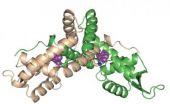(Press-News.org) PROVIDENCE, R.I. [Brown University] — Microorganisms that can break down plant biomass into the precursors of biodiesel or other commodity chemicals might one day be used to produce alternatives to petroleum. But the potential of this "biorefinery" technology is limited by the fact that most microorganisms cannot break down lignin, a highly stable polymer that makes up as much as a third of plant biomass.
Streptomyces bacteria are among few microorganisms known to degrade and consume lignin. Now a group of researchers at Brown University has unlocked the genetic and molecular mechanisms behind a key part of that process. The results are published in the journal Nucleic Acids Research.
Jason Sello, professor of chemistry at Brown, and Rebecca Page, professor in biology in the Department of Molecular Biology, Cell Biology, and Biochemistry, directed the research with graduate students Jennifer Davis and Breann Brown.
"Aside from the implications for biotechnology, this work is significant because it yielded fundamental insights into how bacteria control the expression of their genes," Sello said. "Understanding how genes underlying lignin degradation are regulated could have practical importance in that we could possibly use this information to engineer bacteria that can convert this important component of plant biomass into the biofuels of high-value chemicals."
The consumption of lignin by Streptomyces bacteria is a multistep process. First, the bacteria release enzymes that depolymerize the lignin — break it down into its constituent compounds. The bacteria take up the resulting compounds and use the carbon to support their growth and reproduction. Some of that lignin-derived carbon is converted into triglycerides, the building blocks of biodiesel, and other high-value compounds.
This latest research deals with the second part of that process, the ability of Streptomyces bacteria to metabolize aromatic compounds derived from lignin, which are highly stable and hard to break down.
In previous work, Sello and Davis identified a cluster of genes in Streptomyces bacteria that encode enzymes for breaking down a lignin-derived compound called protocatechuate. Under normal circumstances, those genes were inactive — essentially switched off. Only when bacteria were grown in a medium containing protocatechuate did the genes switch on and produce the appropriate enzymes. In an effort to understand this phenomenon, Sello and Davis discovered that a transcription factor — a kind of protein that attaches itself to DNA — called PcaV was involved in switching the genes on and off. The next step, and the focus of this new research, was figuring out how PcaV controls gene expression.
Sello and Davis proposed a model for how it might work. They proposed that PcaV probably binds to DNA in a way that physically prevents the transcription of the lignin-degrading genes, turning them off. In order to explain how the genes are switched on in the presence of protocatechuate, they proposed that the compound might compromise the ability of PcaV to bind to DNA, which would expose the genes and allow them to be expressed.
A series of experiments provided support for their model. In a test tube, the researchers established that PcaV tightly binds to specific DNA sequences in close proximity to the gene cluster in question, validating the first half of the model. To confirm the second half, Sello and his colleagues exposed the PcaV-DNA complex to protocatechuate. They found that PcaV loses its affinity for DNA in the presence of the compound.
"So we can say that protocatechuate attenuates the DNA binding activity of the PcaV protein, which permits expression of the genes," Sello said. "We now have evidence that validates our model."
Sello and his colleagues then dug down into the process a little further. Using a technique called protein crystallography, the team examined the structure of PcaV in complex with protocatechuate, to gain insight into how the compound affects the capacity of the protein to bind DNA. They found that arginine-15, an amino acid in PcaV, is critical for binding both to protocatechuate and to DNA. On this basis, the group proposed that arginine-15 acts as a molecular switch that is flipped by protocatechuate.
"In the absence of protocatechuate, arginine 15 is important in the binding of PcaV to DNA in a manner that represses transcription," Sello said. "But when you introduce protocatechuate, the arginine spatially reorients to bind the compound. The accompanying conformational changes compromise the ability of the protein to bind to DNA."
An important protein
Beyond possible implications for bioenergy and sustainable chemistry, Sello says the work is meaningful for basic research in bacteriology. PcaV is a member of the MarR family of transcription factors, a family of 12,000 proteins that are known to regulate genes that influence virulence and drug resistance in other types of bacteria.
"It's a very important family of transcription factors in bacteria," Sello said. "Our paper is particularly important because it sheds light on how these proteins control gene expression and mediate responses to small molecules. While many studies of MarR family transcription factors have been published, ours is unique in the way that it synergistically integrates experimental methods from genetics, biochemistry, biophysics, and structural biology."
The research was funded by the National Science Foundation, the National Institutes of Health, and through a seed award from the Office of the Vice President of Research at Brown.
"The collegiality and size of the scientific community at Brown helps to make these collaborative, interdisciplinary research projects work," Sello said.
INFORMATION:
Editors: Brown University has a fiber link television studio available for domestic and international live and taped interviews, and maintains an ISDN line for radio interviews. For more information, call (401) 863-2476.
A microbial biorefinery provides new insight into how bacteria regulate genes
2013-02-15
ELSE PRESS RELEASES FROM THIS DATE:
NASA's Fermi proves supernova remnants produce cosmic rays
2013-02-15
A new study using observations from NASA's Fermi Gamma-ray Space Telescope reveals the first clear-cut evidence the expanding debris of exploded stars produces some of the fastest-moving matter in the universe. This discovery is a major step toward understanding the origin of cosmic rays, one of Fermi's primary mission goals.
"Scientists have been trying to find the sources of high-energy cosmic rays since their discovery a century ago," said Elizabeth Hays, a member of the research team and Fermi deputy project scientist at NASA's Goddard Space Flight Center in Greenbelt, ...
Researchers discover breakthrough in ovarian cancer
2013-02-15
(Phoenix, AZ Feb. 14, 2014) -- Researchers at The University of Arizona Cancer Center at St. Joseph's Hospital and Medical Center in Phoenix have discovered that many women with low-grade serous carcinoma of the ovary or peritoneum have seen their tumors stabilize or shrink after taking a regular dose of the compound selumetinib.
The findings, published in the Feb. 14 edition of The Lancet Oncology, show that selumetinib targets a mutation in the MAPK pathway for patients with low-grade serous carcinoma, allowing for treatment on previously chemoresistant tumors.
"This ...
NASA satellite sees Cyclone Gino's rainfall shoved southward
2013-02-15
NASA's Tropical Rainfall Measuring Mission satellite known as TRMM measured Cyclone Gino's rainfall from space and saw the bulk of precipitation was south of the center. Gino's rainfall is being pushed away from the center by vertical wind shear.
TRMM flew over Cyclone Gino on Thursday, Feb. 14 at 0806 UTC (3:06 a.m. EST) and measured the rainfall rates occurring throughout the storm. The bulk of the rainfall stretched from south to southeast of the center. The heaviest rain was falling at a rate of 2 inches (50 mm) per hour southeast of the center, and scattered throughout ...
Prevention efforts focused on youth reduce prescription abuse into adulthood
2013-02-15
Middle school students from small towns and rural communities who received any of three community-based prevention programs were less likely to abuse prescription medications in late adolescence and young adulthood. The research, published today in the American Journal of Public Health, was funded by the National Institute on Drug Abuse (NIDA), the National Institute on Alcohol Abuse and Alcoholism, and the National Institute of Mental Health, all components of the National Institutes of Health.
"Prescription medications are beneficial when used as prescribed to treat ...
Research finds promising approaches to prevent Latino childhood obesity
2013-02-15
San Diego, CA, February 15, 2013 – Guided grocery store trips, menu labeling at restaurants, community gardens, and video-game-based exercise programs are among several promising, culturally appropriate ways to prevent obesity among Latino children, according to a new collection of studies from Salud America! The Robert Wood Johnson Foundation Research Network to Prevent Obesity Among Latino Children published in a supplement to the March issue of the American Journal of Preventive Medicine.
Salud America! is a national network of researchers, advocates, and policymakers ...
Moffitt researchers find potential new therapeutic target for treating non-small cell lung cancer
2013-02-15
Researchers at Moffitt Cancer Center have found a potential targeted therapy for patients with tobacco-associated non-small cell lung cancer. It is based on the newly identified oncogene IKBKE, which helps regulate immune response.
The study appeared in the Feb. 13 online issue of Oncogene.
The IKBKE gene is part of a family of enzyme complexes involved in increasing cellular inflammation. IKBKE overexpression has been associated with breast and prostate cancers. However, it had not been linked to environmental carcinogen, such as tobacco smoke, until now.
Tobacco ...
Can police withdraw blood from DWI suspects without a warrant?
2013-02-15
Can police withdraw blood from DWI suspects without a warrant?
Article provided by Ellis & Ortega, LLC
Visit us at http://www.theortegalawgroup.com
In early 2013, the Supreme Court of the United States will hear a case regarding the constitutionality of law enforcement drawing blood from a drunken driving suspect without first obtaining a warrant. At the heart of the case is whether blood tests without a warrant violate the Fourth Amendment's protection from unreasonable search and seizure.
The history of the Supreme Court case
The case the Supreme Court ...
Elder abuse in California is no laughing matter
2013-02-15
Elder abuse in California is no laughing matter
Article provided by The Law Office of Kevin P. Kane, Esq.
Visit us at http://www.kevinpkane.com
Elder care abuse is a serious issue in California that can manifest as both physical and financial harm. An experienced attorney can help create a plan that will minimize the risk of harm and can fight for damages if the harm has already occurred.
What are the warning signs?
Elder abuse is an umbrella term for a whole host of different reproachable behavior. That said, there are some warning signs that can alert someone ...
Social security disability benefit for injured veterans
2013-02-15
Social security disability benefit for injured veterans
Article provided by Chris R. Borgia, Esq.
Visit us at http://www.socialsecuritydisabilitylaw.net
Military servicepersons injured while on active duty can request an expedited processing of claims for Social Security Disability benefits. Military servicepersons who became disabled while on active duty on or after October 1, 2001 qualify for an expedited processing. To file a claim in Florida, the injury need not have occurred in Florida.
Social Security disability benefits and Supplemental Security Income
Military ...
Planning for the future: Who will make the decisions?
2013-02-15
Planning for the future: Who will make the decisions?
Article provided by Jill M. Metz & Associates
Visit us at http://www.jillmetzlaw.com
For most people, it's almost unthinkable. An accident you never saw coming. An illness that strikes like lightning. No one likes to imagine it, let alone plan for it, but things happen. There might come a day when you cannot make decisions for yourself. Then what would happen? You can leave your fate to chance. Or, through a bit of legal work now, you can take control. The first step is to determine which type of legal document ...


